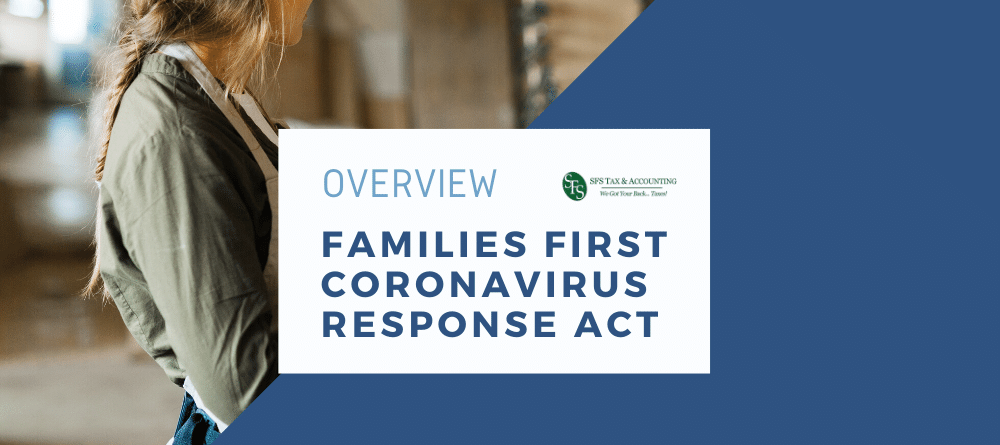On March 18, 2020, the Families First Coronavirus Response Act was signed into law, marking the second major legislative initiative to address COVID-19. The overview below provides a summary of key provisions of the Families First Act, which includes the key points in the law.
Families First Coronavirus Response Act
- The new law requires that small business to provide paid leave
- Families First Coronavirus Response Act provides worker benefits.
- The Families First Coronavirus Response Act is the new law passed that offers COVID-19 assistance for both employees and employers.
- This new law provides businesses with fewer than 500 employees the funds to provide employees with paid leave, either for the employee’s own health needs or to care for family members.
Here are the details of the new law’s benefits:
- Paid Sick Leave for Workers: The new law provides employees of eligible employers two weeks (up to 80 hours) of paid sick leave at 100% of the employee’s pay where the employee can’t work because the employee is quarantined and/or experiencing COVID-19 symptoms and seeking a medical diagnosis.
- Other Paid Leave for Workers: Employees can receive two weeks (up to 80 hours) of leave at two-thirds the employee’s pay if they need to care for someone in the following situations: The need to care for an individual subject to quarantine, to care for a child whose school is closed or childcare provider is unavailable for reasons related to COVID-19.
- Extended Leave: In some instances, an employee may receive up to an additional ten weeks of expanded paid family and medical leave at two-thirds the employee’s pay.
- Companies will get paid back: Businesses who pay employees the mandatory sick and childcare leave according to the new law will get completely reimbursed through a payroll tax credit.
What it means for you:
- Employees can take the necessary time to recover after having been infected with COVID-19 or to care for a loved one, without fear of losing their job or salary.
- Employers can help their employees financially while navigating COVID-19 related shutdowns.
Employees that were laid-off or fired are not eligible for emergency paid leave benefits.
- If your office is closed and you have temporarily laid off or fired your employees, they are not eligible for paid leave benefits under this law. Instead, they can file for unemployment benefits. This is true whether you close due to lack of business or because it is required to close pursuant to a Federal, State, or local directive.
- If your office is still open, but you have temporarily furloughed some employees due to lack of work, these employees are not eligible for paid leave under this law but should apply for unemployment benefits.
- This is important news for many employers. It means that you DO NOT need to lay your employees off (i.e., terminate their employment) to avoid having to pay leave benefits under this law.
Employees who continue to work remotely or otherwise, after the law is effective will be eligible for paid leave benefits.
- Tax Credits
- 100% Tax credits are available for employers who pay employees emergency Paid Sick leave and who pay employees emergency Paid Family And Medical Leave. The tax credits cover payments made to employees who qualify for leave under the law (up to the maximum daily/aggregate amounts) as well as payments made to maintain the employee’s health insurance coverage during the leave.
- For businesses to be able to afford these payments during these difficult times, the IRS has implemented a system for prompt payment of tax credits.
- The tax credit is only given for payments made as required under this law. So, if an employer chooses to pay an amount that goes above and beyond the cap provided by law, there’s no tax credit for that extra amount. If an employer is not subject to this law but chooses to offer pay, there is no available tax credit.
Emergency Paid Sick Leave
- All employers with fewer than 500 employees are required to offer two weeks (or the hourly equivalent of an employee’s usual workload over the course of two weeks) of paid sick leave to all employees under certain circumstances in addition to any Paid Sick Leave they offered before the law was enacted. The requirement to provide federally mandated sick leave expires on December 31, 2020.
When does this benefit apply?
Employees are entitled to emergency paid sick leave if (and only if) they are:
- Subject to a federal, state, or local quarantine or isolation order related to COVID-19;
- Advised by a healthcare provider to self-quarantine due to COVID-19 concerns;
- Experiencing COVID-19 symptoms and seeking medical diagnosis;
- Caring for an individual subject to a federal, state, or local quarantine or isolation order or advised by a health care provider to self-quarantine due to COVID-19 concerns;
- They must care for their child if the child’s school or place of care is closed or the child’s care provider is unavailable due to public health emergency;
- THIS IS THE ONLY SCENARIO WHERE GRANTING 12 WEEKS OF FMLA COMES INTO PLAY
- They experience any other substantially similar condition specified by the Secretary of Health and Human Services in consultation with the Secretary of the Treasury and the Secretary of Labor.


